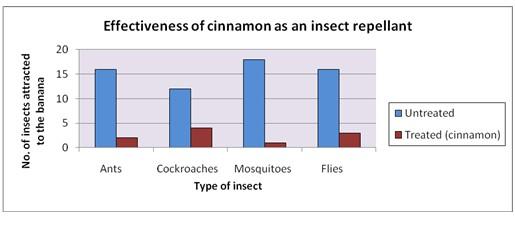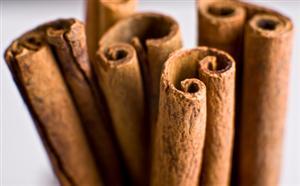| Complexity level: | 5 |
| Project cost ($): | 20 |
| Time required: | Preparations will take approximately one day, four hours are required for observation |
| Material availability: | Easily found |
| Safety concerns: | Basic safety requirements |
Hypothesis
Cinnamon oil is an effective natural insect repellant against insects such as ants, cockroaches, mosquitoes and flies.
Overview
Natural pesticides
Pesticides destroy or repel insects and pests that are present in our homes and gardens, and may also serve to prevent others from entering our premises. Some insects damage our property and spread diseases. Some are unhygienic and are capable of contaminating our food. Most pesticides that we purchased at the supermarket are synthesized from chemicals, which when inhaled, are harmful to our health. In addition, the use of pesticides in places such as farms may contaminate the food chain and drinking water, since the chemicals present in these pesticides may seep into the soil.
Natural pesticides are an alternative to chemical pesticides. These pesticides are made from the natural extracts from plants, herbs, flowers, seeds or salt minerals. Hence, most natural pesticides are environment friendly and safe for us to use. However, there are exceptions - for example nicotine, which is more toxic then some of the more common chemical pesticides.
Some common natural pesticides are cinnamon, lemon juice, cucumber peel or bay leaves to keep ants away. Borax, a salt crystal, is also particularly effective in repelling cockroaches and termites. Another common natural pesticide is honey, which can be used to attract and trap flies. Once these flies land on the honey, they are not capable of flying off again.
Scientific Terms
Materials
Materials required for this science fair project:
- 4 empty fish tanks with covers
- 1 bottle of cinnamon oil
- 3 empty plastic bottles
- 1 larger container
- 4 over-ripe bananas
- 1 knife
- 20 ants
- 20 cockroaches
- 20 mosquitoes
- 20 flies
- 1 stopwatch
Procedure
1. The independent variable in this science fair project is the type of insect used – ants, cockroaches, mosquitoes and flies. The dependent variable is the number of insects present on the bananas, which is determined though observing the behavior of the insects towards the bananas placed in the fish tank for one hour. The constants (control variables) are the number of insects used, the time taken for each set of observations, and the size of the fish tank.
2. The effectiveness of cinnamon oil will be investigated on four types of insects - ants, cockroaches, mosquitoes and flies. Prior to the start of the experiment, label the three plastic bottles as A, M and F to represent ants, mosquitoes and flies. Label the larger plastic container as C to represent cockroaches. In addition, mark each fish tank with the labels A,C,M and F.
3. Prior to the experiment, you need to search for 20 insects of each type, and keep each type of insect in their respective plastic bottles or containers.
4. Peel the four bananas and cut them into halves. Coat a layer of cinnamon oil on the surface of one half of each banana. Leave the other half untreated. Place both halves of each banana into a fish tank, and keep them as far away as possible from each other. Each of the four fish tanks must contain a treated half of a banana, and an untreated half.
5. Release each type of insect into each fish tank according to the labels made earlier. Observe the behavior of the insects towards the split bananas in the fish tank for one hour. When the hour is up, count the number of insects that went for the untreated banana, and insects that went for the the cinnamon coated banana. Record the observations in the table given below.

Results
It was observed that most of the insects avoided the cinnamon coated banana. The few that went towards the cinnamon coated banana only spent a short time on its surface. Instead, majority of the insects were attracted to the untreated banana, and either stayed on the surface of the untreated banana or remained in its vicinity.
It was also observed that there were some insects that stayed on the wall of the tank instead of either half of the bananas.
| Condition of banana | Number of insects that stayed on the surface of a banana or remained near its vicinity | |||
| Ants | Cockroaches | Mosquito | Flies | |
| Untreated | 16 | 12 | 18 | 16 |
| Cinnamon-coated | 2 | 4 | 1 | 3 |
Use the graph below to plot the results of the observations recorded in the table above.

Conclusion
From the data recorded in the table and plotted on the graph, it can be seen that insects were attracted to the untreated banana, while the layer of cinnamon on the other banana repelled the majority of the insects.
As such, the experimental data collected supports the hypothesis that cinnamon oil is an effective natural insect repellant against insects such as ants, cockroaches, mosquitoes and flies.
Natural pesticides use extracts from herbs, fruits and vegetables to keep our homes free of insects and pests. Although natural pesticides are only effective for a shorter period of time and may be more expensive than conventional chemical pesticides, natural pesticides are safer to use and are more environment friendly. As children are especially vulnerable to the fumes released from chemical pesticides, the use of natural pesticides is recommended in homes.
Also consider
What would happen if this science fair project were to be repeated using different type of natural insecticides such as clover or lime juice?
The experiment can also be done using different types of natural substance like vinegar or Borax salt.
Does varying quantity of the natural insecticide used make a difference to your results?
References
Natural pesticide alternatives - http://www.essortment.com/all/pesticidesalter_rfhc.htm
Natural pesticides - http://www.livingwithbugs.com/natural_pesticides.html
How to kill ant with natural pesticides - http://www.associatedcontent.com/article/685561/how_to_kill_ants_with_natural_pesticides_pg2.html?cat=32

